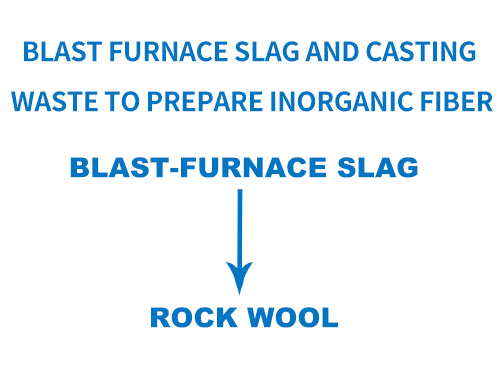INFORMATION DETAILS
Equipment and method for preparing inorganic slag fibers from blast furnace slag
Author:Dongli Time:2024-01-08 14:51:30 Click:186
The present invention belongs to the industry of inorganic non-metallic material preparation technology equipment. Specifically, it relates to an equipment for producing inorganic slag fibers, in particular to an equipment for preparing inorganic slag fibers using hot blast furnace slag, and a method for preparing inorganic slag fibers using the equipment
Hot blast furnace slag is a by-product discharged from the blast furnace during the smelting of pig iron, and is currently the most important smelting waste in China. In the ironmaking process, in addition to iron ore and fuel (coke), a considerable amount of limestone and dolomite need to be added as fluxes to the blast furnace raw materials. As the burden melts, the gangue in the ore, ash in the coke, co solvents, and other impurities that cannot enter the pig iron interact to form a hot blast furnace slag, mainly composed of silicate and aluminate, floating on top of the molten iron. The emissions of hot blast furnace slag per ton of pig iron production vary with different ore grades and smelting methods. Generally, the slag production per ton of pig iron is 300-900kg. With the development of China's steel industry, the emissions of hot blast furnace slag are increasing day by day Hot blast furnace slag is a high-temperature waste directly generated from blast furnace ironmaking, with a temperature of up to around 1500 ℃. Its main mineral composition includes calcium feldspar, magnesium feldspar, calcium feldspar, pyroxene, wollastonite, tricalcium disilicate, etc. Generally speaking, 1 ton of hot slag, i.e. hot blast furnace slag, carries 1600-1800 MJ of heat, which is approximately equivalent to the heat generated after the combustion of 55-61 kg of standard coal. If calculated based on the national industrial slag production of 350 million tons in 2005, this part of the slag, due to not fully utilizing its sensible heat, wastes approximately 28 million tons of thermal energy equivalent to raw coal In order to fully utilize the sensible heat in the hot blast furnace slag, as early as the 1950s, China used compressed air or high-pressure steam as the injection medium at the end of the hot blast furnace slag ditch, which is passed through the nozzle. The molten hot blast furnace slag without any tempering or temperature adjustment treatment was directly sprayed into slag cotton fibers. Although this method utilizes the sensible heat of hot blast furnace slag, due to the presence of alkaline oxides such as calcium oxide and magnesium oxide in hot blast furnace slag, its alkalinity is high, and the high-temperature liquid viscosity is high, which is not conducive to fiber formation and is not suitable for direct fiber formation. Experimental results have shown that using hot blast furnace slag as the main raw material and adding other substances (such as fly ash) for quenching and tempering, excellent inorganic slag fibers can be prepared. These fibers have excellent characteristics such as high temperature resistance (based on actual reports), corrosion resistance, good strength, light weight, good electrical insulation, low moisture absorption, and small elongation. They are widely used in various industrial sectors and daily industries, and have broad application prospects. Among them, the mentioned fly ash refers to the solid particles generated during the combustion process of coal-fired (low calorific value fuel) boilers. In 2005, low calorific value coal-fired power plants in China produced 330 million tons of fly ash, accounting for 40% of the country's industrial solid waste The key issue restricting the development of this technology is how to uniformly mix the added substances with hot blast furnace slag. At high temperatures ranging from 1400 ℃ to 1500 ℃, solid quenched and tempered substances such as fly ash added to the molten hot blast furnace slag are difficult to uniformly blend with the hot blast furnace slag due to factors such as hot air movement and melt structure, making it difficult to prepare inorganic slag fibers with uniform and excellent quality. Therefore, the problem of solid mixing seriously restricts the promotion and application of the technology of using hot blast furnace slag to prepare inorganic slag fibers. How to solve this problem, prepare excellent inorganic slag fibers, and achieve the improvement of waste utilization efficiency, full utilization of waste energy, promote China's economy and society, and have profound significance for the harmonious development of human and nature, as well as the leap from resource economy to circular economy CONTACT
CONTACT
—— Tel:+86-13930107143
—— Contacts:Mr Wang
—— Add:Wei San Road South, Hope New Area, Mengcun Hui Autonomous County, Cangzhou City, Hebei Province






